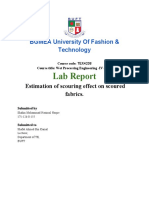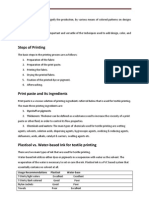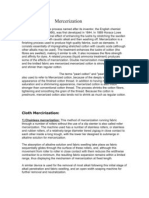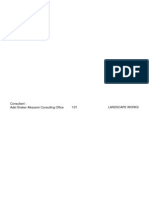100%(1)100% found this document useful (1 vote)
239 viewsIntroduction of Dyeing PDF
Introduction of Dyeing PDF
Uploaded by
ImranThe document discusses dyeing and pigmenting textiles. Dyeing involves chemically or physically changing a textile to impart color in a uniform way. Dyes are soluble colorants that are applied through exhaust or continuous dyeing machines. Pigments provide color through insoluble particles. Different dyeing methods are used depending on the fiber and textile production stage, such as yarn dyeing. The dyeing process involves distribution of dye between the dye bath and textile surface until equilibrium is reached through various interactions.
Copyright:
© All Rights Reserved
Available Formats
Download as PDF, TXT or read online from Scribd
Introduction of Dyeing PDF
Introduction of Dyeing PDF
Uploaded by
Imran100%(1)100% found this document useful (1 vote)
239 views13 pagesThe document discusses dyeing and pigmenting textiles. Dyeing involves chemically or physically changing a textile to impart color in a uniform way. Dyes are soluble colorants that are applied through exhaust or continuous dyeing machines. Pigments provide color through insoluble particles. Different dyeing methods are used depending on the fiber and textile production stage, such as yarn dyeing. The dyeing process involves distribution of dye between the dye bath and textile surface until equilibrium is reached through various interactions.
Original Title
Introduction of Dyeing.pdf
Copyright
© © All Rights Reserved
Available Formats
PDF, TXT or read online from Scribd
Share this document
Did you find this document useful?
Is this content inappropriate?
The document discusses dyeing and pigmenting textiles. Dyeing involves chemically or physically changing a textile to impart color in a uniform way. Dyes are soluble colorants that are applied through exhaust or continuous dyeing machines. Pigments provide color through insoluble particles. Different dyeing methods are used depending on the fiber and textile production stage, such as yarn dyeing. The dyeing process involves distribution of dye between the dye bath and textile surface until equilibrium is reached through various interactions.
Copyright:
© All Rights Reserved
Available Formats
Download as PDF, TXT or read online from Scribd
Download as pdf or txt
100%(1)100% found this document useful (1 vote)
239 views13 pagesIntroduction of Dyeing PDF
Introduction of Dyeing PDF
Uploaded by
ImranThe document discusses dyeing and pigmenting textiles. Dyeing involves chemically or physically changing a textile to impart color in a uniform way. Dyes are soluble colorants that are applied through exhaust or continuous dyeing machines. Pigments provide color through insoluble particles. Different dyeing methods are used depending on the fiber and textile production stage, such as yarn dyeing. The dyeing process involves distribution of dye between the dye bath and textile surface until equilibrium is reached through various interactions.
Copyright:
© All Rights Reserved
Available Formats
Download as PDF, TXT or read online from Scribd
Download as pdf or txt
You are on page 1of 13
Introduction to Dyeing
Dyeing
The process by which a textile material is
changed physically or chemically so that it
looks colorful is called Dyeing.
The objective of dyeing is to produce uniform
colorations of a substrate usually to match a
pre-selected color. The color should be
uniform throughout the substrate and be of a
solid shade with no unlevelness or change in
shade over the whole substrate.
Dyestuff
Dyes are colored, unsaturated organic or
inorganic chemical compounds capable of
giving color to substrate (textile) i.e.
coloring or dyeing it. Dyes can be formed
synthetically from relatively cheap basic
products where specific functional groups
in the dyes which determine or affect the
applicability and fastness.
Characteristics of dyestuff
Must contain chromophore groups.
This chromophore groups may be different
types.
Example; -NO2, -NH2, -CO-, -N=O etc.
Must able of preparing dilute solution by
dissolving water i.e. solubility
Must be power of entering dyestuff to fibre
from dye bath i.e. substantivity.
Should have fastness property.
Pigments
A pigment is a material that changes the color of reflected or
transmitted light as the result of wavelength-selective absorption.
Advantage:
Light fastness very high.
Low cost
Easy process
Low process time
It can used with any fiber.
Disadvantage: Harsh fabric, Rubbing fastness is very poor.
Required criteria of pigments
Pigments should have good covering power.
Pigments should have freely mixing properties.
Pigments should be chemically inert.
Pigments should have good resistance to Acid.
Pigments should be resistance to solvent.
Pigments should have suitable brilliance ,
hardness, and stability.
Pigments should have good wet , light, and
abrasion resistance.
Pigments should have good characteristics for
excellent
Method of Dyeing
Colour is applied to fabric by different methods of dyeing for different
types of fiber and at different stages of the textile production process.
Dyeing can be done during any stage in the textile manufacturing
process. Textiles may be dyed as fibre, as yarn, as fabric, as garments,
depending upon the type of the fabric or garment being produced.
These methods include:
Direct dyeing;
Stock dyeing;
Top dyeing;
Yarn dyeing;
Piece dyeing;
Garment dyeing
Solution pigmenting or dope dyeing etc.
Of these Direct dyeing and Yarn Dyeing methods are the most popular
ones.
Exhaust or Batch dyeing
In exhaust dyeing the dye, which is wholly or partially
soluble in the dyebath, is transported to the fibre
surface by the motion of the dye liquor or by motion
of the substrate being dyed.
The dye is adsorbed onto the fibre surface and ideally
diffuses into the whole of the fibre.
Depending upon the dye being used, the interactions
between the dye and the fibre can be either chemical
or physical.
Exhaust dyeing is usually conducted using dilute
solutions of dyes, normally termed long liquor dyeing,
and can involve liquor to substrate ratios from 8:1 up
to 30:1.
Exhaust dyeing machines
Continuous dyeing
Continuous dyeing is a process whereby dyeing the
fabric and fixation of the dye are carried out
continuously in one simultaneous operation.
This is traditionally accomplished using a
production line system where units are assembled
into lines of consecutive processing steps; this can
include both pre- and post-dyeing treatments.
Fabric is usually processed in open width, so care
must be taken not to stretch the fabric.
Continuous dyeing machines
Theory of Dyeing
The dyeing process is essentially a distribution process. The dye is
distributed over at least two phase systems; the dye bath and textile
mtls. When equilibrium dyeing is reached, the following subsidary
equilibria are established:
1. Dye dispersed in the dyebath: Most of the dyes in solution are
in molecular and partially ionised state or exist in the form of ionic
micells.
2. Dye in the diffusion layer: Dye molecules then come into the
diffusion layer of the fibre and enter into it.
3. Dye in the electrical double layer: All textile fibres when
immersed in water or aqueous solution, acquire an electrical
potential after referred to as Beta potential. The covalent and
hydrogen bond forces which anchor the dye to the fibre are of
short range of the order of 10A to 50A. The electrostatic forces
have a range about 1000a where there is a mutual repulsion
between the fibre and the dye ion, an extremely long time will be
necessary before the inherent vibration of the molecules in the
solution.
Theory of Dyeing
4. Dye at the fibre surface: Increase of temp. helps to
accelerate the migration of dye molecules to the surface of
the fibre.
5. Dye in the fibre: Dye diffused in the fibre. Owing to the
high temp. there is always an abundance of dye stuff
molecules in the vicinity of the fibre and agitation has little
effect upon the time of half dyeing.
6. Dyes physically and chemically bond with polymer:
The following factor are responsible for the anchoring of the
dye molecules to the fibre:
Ionic links; for protein fibre.
Hydrogen bonds; for cellulosic fibre.
Covalent bonds; between carbon atoms
Physical forces.
You might also like
- Tortle Package (5e)Document28 pagesTortle Package (5e)Jorge LealNo ratings yet
- Vat PrintingDocument4 pagesVat PrintingKhandaker Sakib Farhad67% (3)
- Finishing of Terry TowelsDocument2 pagesFinishing of Terry TowelspcNo ratings yet
- Modern Cotton Spinning Machinery, Its Principles and ConstructionFrom EverandModern Cotton Spinning Machinery, Its Principles and ConstructionNo ratings yet
- 3) Theory of DyeingDocument12 pages3) Theory of DyeingSanaullah Murad100% (1)
- Disperse DyeDocument3 pagesDisperse DyeMD saifu lislamNo ratings yet
- Methods of DyeingDocument13 pagesMethods of DyeingShahan AkhtarNo ratings yet
- Solvent DyeingDocument11 pagesSolvent DyeingMd Makhdum Amin Fahim100% (1)
- Textile Dyeing - Introduction-LibreDocument10 pagesTextile Dyeing - Introduction-LibreGanga Dharan100% (1)
- Colour Matching TriangleDocument3 pagesColour Matching TriangleArun KumarNo ratings yet
- Estimation of Scouring Effect On Scoured Fabrics.Document3 pagesEstimation of Scouring Effect On Scoured Fabrics.nasimul haqueNo ratings yet
- List of DefectsDocument5 pagesList of DefectsIRFANA ASLAM100% (2)
- National Textile University Faculty of Engineering & TechnologyDocument11 pagesNational Textile University Faculty of Engineering & TechnologyShahan Akhtar100% (1)
- Jigger and Winch Dyeing MachineDocument10 pagesJigger and Winch Dyeing MachineSajid arNo ratings yet
- Direct DyeDocument4 pagesDirect DyeEusha NightangelNo ratings yet
- Dyeing Defects and Their RemediesDocument5 pagesDyeing Defects and Their RemediesMuhammad ImranNo ratings yet
- Jigger Dyeing Machine:: Fabric PreparationDocument2 pagesJigger Dyeing Machine:: Fabric PreparationnaaomaiNo ratings yet
- Thesis Presentation of Wet Processing Group 8Document37 pagesThesis Presentation of Wet Processing Group 8Nirnoy ChowdhuryNo ratings yet
- Reactive Printing PDFDocument9 pagesReactive Printing PDFshivanshNo ratings yet
- Dyeing FaultsDocument10 pagesDyeing FaultsMehedi Hassan EvanNo ratings yet
- PrintingDocument7 pagesPrintingSajib Mahmud ShahriarNo ratings yet
- Dyeing of Blends: Submitted To-Submitted byDocument32 pagesDyeing of Blends: Submitted To-Submitted byMehak Deep75% (4)
- DPF Lab Report (8-13)Document25 pagesDPF Lab Report (8-13)Jisun AhmedNo ratings yet
- Acid DyeDocument3 pagesAcid DyeMD. Tofazzal HossainNo ratings yet
- Direct DyesDocument53 pagesDirect DyesKashif Chaudhry100% (1)
- BiopolishingDocument8 pagesBiopolishingSivakumar KNo ratings yet
- MercerizationDocument3 pagesMercerizationsyed asim najam100% (1)
- Industrial Report of AnlimaDocument96 pagesIndustrial Report of AnlimaShuvoRahaman100% (1)
- Dyeing Theory PDFDocument50 pagesDyeing Theory PDFRamnath Kumar Yadav100% (2)
- Textile Preparatory Processing GemedaDocument83 pagesTextile Preparatory Processing GemedaGemeda GebinoNo ratings yet
- Textile Dyeing LectureDocument28 pagesTextile Dyeing LectureMuhammad Zohaib100% (1)
- Discharge PrintingDocument16 pagesDischarge Printingsakshi_mehra123No ratings yet
- Textile Wet Processing UNIT-4Document6 pagesTextile Wet Processing UNIT-4Chaarvi SaranyaNo ratings yet
- Continuous Dyeing MachineDocument18 pagesContinuous Dyeing Machinebigstar42100% (1)
- Pre Treatment For Fabrics Before DyeingDocument16 pagesPre Treatment For Fabrics Before DyeingNayomi Rathnaweera0% (1)
- Acrylic Yarn DyeingDocument4 pagesAcrylic Yarn Dyeingsusheel deora0% (1)
- 191003060-Lab Report 5Document6 pages191003060-Lab Report 5Tanzila NusratNo ratings yet
- Woven Fabric Defects and InspectionDocument37 pagesWoven Fabric Defects and InspectionShresha DasNo ratings yet
- Mechanical FinishingDocument43 pagesMechanical FinishingUjwala Jain100% (1)
- Fabric Dyeing ProcessDocument8 pagesFabric Dyeing ProcessNikita JainNo ratings yet
- Wet Processing TechnologyDocument32 pagesWet Processing TechnologyProfessorTextech100% (1)
- Vat DyeDocument13 pagesVat DyeTanmoy AntuNo ratings yet
- Printing Techniques and Printing Defects11Document15 pagesPrinting Techniques and Printing Defects11Supriya Bagh100% (1)
- Dyeing OverviewDocument38 pagesDyeing OverviewAmdeworkNo ratings yet
- Development of Jute / Cotton Blended Garment For Winter Wear By: B. Sathish BabuDocument31 pagesDevelopment of Jute / Cotton Blended Garment For Winter Wear By: B. Sathish BabuAjaz Banna100% (1)
- Methods of ColorationDocument11 pagesMethods of ColorationFerdous Khan RubelNo ratings yet
- Textile Finishing - Textile CentreDocument17 pagesTextile Finishing - Textile CentreashrafbookNo ratings yet
- Mercerization 140503095002 Phpapp01Document68 pagesMercerization 140503095002 Phpapp01mudit bhargava100% (1)
- Wet Processing Engineering - WikipediaDocument51 pagesWet Processing Engineering - WikipediaFahad AliNo ratings yet
- Dyeing Process of Cotton Fabric With Reactive DyesDocument6 pagesDyeing Process of Cotton Fabric With Reactive DyesMianAbrarAnjumNo ratings yet
- 14 - Printing PresentationDocument81 pages14 - Printing PresentationVinalee Seneviratne100% (1)
- Types of Dyeing ProcessesDocument5 pagesTypes of Dyeing ProcessesSyed Inamullah ShahNo ratings yet
- Study On Different Types of Dyeing Faults PDFDocument10 pagesStudy On Different Types of Dyeing Faults PDF呂仲書100% (1)
- Presentation On Mercerization ParametersDocument40 pagesPresentation On Mercerization ParametersSaif Rahman100% (1)
- Ecofriendly Methods of Pre Treatment Textile ProcessingDocument41 pagesEcofriendly Methods of Pre Treatment Textile ProcessingNikithaaNo ratings yet
- Wet Lab ManualDocument64 pagesWet Lab ManualSudip TalukdarNo ratings yet
- Reactive DyesDocument45 pagesReactive DyesRavi AdityaNo ratings yet
- DPF 10 PDFDocument26 pagesDPF 10 PDFMd. Sabbir Sabbir HossainNo ratings yet
- Chemistry Project 12Document18 pagesChemistry Project 12Surya Krishna MoorthyNo ratings yet
- Difference Between Dyes and PigmentsDocument5 pagesDifference Between Dyes and PigmentsHameedullah Ansari100% (1)
- Basic Garment ConstructionDocument9 pagesBasic Garment ConstructionImran100% (1)
- Woven Shirt Fabric Consumption CalculationDocument9 pagesWoven Shirt Fabric Consumption CalculationImranNo ratings yet
- Export Import Process in BangladeshDocument18 pagesExport Import Process in BangladeshImranNo ratings yet
- Assignment On Textile Manufacturing Process of Fibre To Garment of ShirtDocument26 pagesAssignment On Textile Manufacturing Process of Fibre To Garment of ShirtImranNo ratings yet
- Cost and Time Savings of Apparel Industry Through Elimination of Non-Valuated Process in Cutting SectionDocument9 pagesCost and Time Savings of Apparel Industry Through Elimination of Non-Valuated Process in Cutting SectionImranNo ratings yet
- Peh 1 Handout 2Document3 pagesPeh 1 Handout 2julie jane arcillaNo ratings yet
- All Gardens AreaDocument21 pagesAll Gardens AreaMarius BarbuNo ratings yet
- Hydraulic System (Indo)Document20 pagesHydraulic System (Indo)Rico SuhandaNo ratings yet
- Personal Safety Protocol During Moderate Vigorous Physical Activities MVPA ParticipationDocument13 pagesPersonal Safety Protocol During Moderate Vigorous Physical Activities MVPA ParticipationGEIAN TALABOC LAVADORNo ratings yet
- Project Proposal On Environment & Climate ChangeDocument16 pagesProject Proposal On Environment & Climate ChangeJan Oliver PugalNo ratings yet
- Unit 1 Introduction To Data StructureDocument41 pagesUnit 1 Introduction To Data StructureVansh ThakurNo ratings yet
- During Pre-Historic Period: "Ager" "Cultura"Document6 pagesDuring Pre-Historic Period: "Ager" "Cultura"Trisha Mae AlicnasNo ratings yet
- Cat Casseforme UKDocument12 pagesCat Casseforme UKMilan UljarevicNo ratings yet
- PrehistoryDocument45 pagesPrehistoryAnonymous 7GXIcV100% (2)
- Introduction To PhilosophyDocument5 pagesIntroduction To PhilosophysleeplessPianistNo ratings yet
- A First Course in Group TheoryDocument2 pagesA First Course in Group TheoryFirdous Ahmad Mala100% (1)
- Tle 6 Worksheets PDFDocument85 pagesTle 6 Worksheets PDFJohn Paul CapalaranNo ratings yet
- Enhancing Performance and Stability of Gain-Scheduling Control SystemDocument21 pagesEnhancing Performance and Stability of Gain-Scheduling Control SystemAisha Sir ElkhatemNo ratings yet
- Tubular Inside Micrometers: FeaturesDocument2 pagesTubular Inside Micrometers: Featureschmatias3No ratings yet
- Guia - Present Simple PositiveDocument4 pagesGuia - Present Simple PositiveYEIMY PADILLANo ratings yet
- Datasheet tl431 Regulador ProgramavelDocument10 pagesDatasheet tl431 Regulador Programavelmestre_giovasNo ratings yet
- Track 1Document17 pagesTrack 1Frada GaramanNo ratings yet
- Digital Twin For A 10 MW Electrical Drive System For Future Electric Aircraft ApplicationsDocument9 pagesDigital Twin For A 10 MW Electrical Drive System For Future Electric Aircraft Applicationsanandhu r nairNo ratings yet
- Owner'S Manual: SEAT Recommends Seat SEAT Recommends Castrol EDGE ProfessionalDocument324 pagesOwner'S Manual: SEAT Recommends Seat SEAT Recommends Castrol EDGE ProfessionaltabaraiNo ratings yet
- Purlin Design Wet BlockDocument1 pagePurlin Design Wet Blocksaltore123456No ratings yet
- Santa Cruz Academy, Inc.: Senior High School Learning PlanDocument5 pagesSanta Cruz Academy, Inc.: Senior High School Learning Planchan borbonNo ratings yet
- Chapter 2 Look at Our EnvironmnetDocument22 pagesChapter 2 Look at Our EnvironmnetCindyNo ratings yet
- Bolt Tightening Handbook Linear Motion ADocument44 pagesBolt Tightening Handbook Linear Motion AMarcos MorachickNo ratings yet
- Healthy BLDC Motor Simulation Using Finite Element Analysis-IJAERDV04I1073133Document12 pagesHealthy BLDC Motor Simulation Using Finite Element Analysis-IJAERDV04I1073133MiteshJadhavNo ratings yet
- Onga WS1500200-210 TdsDocument2 pagesOnga WS1500200-210 Tdsestimate kingNo ratings yet
- Idat 2019: Sample Paper Instructions: Section A: Creative & Visual AbilityDocument13 pagesIdat 2019: Sample Paper Instructions: Section A: Creative & Visual AbilityArti SinghNo ratings yet
- Winter Activities + Song PDFDocument9 pagesWinter Activities + Song PDFSvitlana LukinaNo ratings yet
- Tariff and Basis of ChargingDocument6 pagesTariff and Basis of ChargingmdNo ratings yet
- Progress Test 1 - Attempt ReviewDocument15 pagesProgress Test 1 - Attempt ReviewQuân NguyễnNo ratings yet






























































































